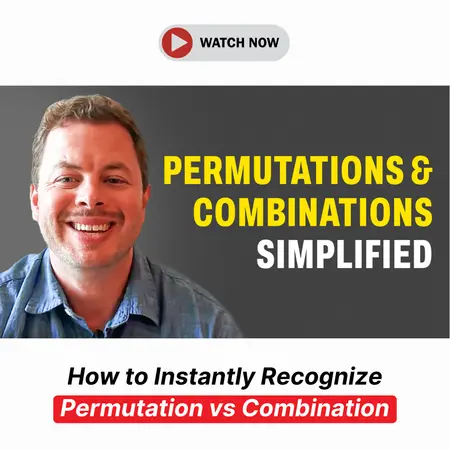Events & Promotions
|
|

GMAT Club Daily Prep
Thank you for using the timer - this advanced tool can estimate your performance and suggest more practice questions. We have subscribed you to Daily Prep Questions via email.
Customized
for You
Track
Your Progress
Practice
Pays
Not interested in getting valuable practice questions and articles delivered to your email? No problem, unsubscribe here.
- Nov 20
07:30 AM PST
-08:30 AM PST
Learn what truly sets the UC Riverside MBA apart and how it helps in your professional growth - Nov 22
11:00 AM IST
-01:00 PM IST
Do RC/MSR passages scare you? e-GMAT is conducting a masterclass to help you learn – Learn effective reading strategies Tackle difficult RC & MSR with confidence Excel in timed test environment - Nov 23
11:00 AM IST
-01:00 PM IST
Attend this free GMAT Algebra Webinar and learn how to master the most challenging Inequalities and Absolute Value problems with ease. - Nov 25
10:00 AM EST
-11:00 AM EST
Prefer video-based learning? The Target Test Prep OnDemand course is a one-of-a-kind video masterclass featuring 400 hours of lecture-style teaching by Scott Woodbury-Stewart, founder of Target Test Prep and one of the most accomplished GMAT instructors.
Kudos
Bookmarks
E
Be sure to select an answer first to save it in the Error Log before revealing the correct answer (OA)!
Difficulty:
 85%
(hard)
85%
(hard)
Question Stats:
68% (02:42) correct 32%
(03:07)
wrong
32%
(03:07)
wrong  based on 1339
sessions
based on 1339
sessions
History
Date
Time
Result
Not Attempted Yet
Bob expected to spend a total of $9.00 to buy a given amount of pasta salad at a fixed price per pound. However, the price of the salad was $0.20 more per pound than Bob had expected. Consequently, he spent $9.00 and bought \(\frac{1}{2}\) pound less of the salad. How much did Bob spend per pound for the salad?
A. $1.80
B. $1.85
C. $1.90
D. $1.95
E. $2.00
A. $1.80
B. $1.85
C. $1.90
D. $1.95
E. $2.00
avigutman
 Expert
Expert
Tutor
Joined: 17 Jul 2019
Last visit: 30 Sep 2025
Posts: 1,293
Given Kudos: 66
Location: Canada
Schools: NYU Stern (WA)
GMAT 1: 780 Q51 V45

GMAT 2: 780 Q50 V47

GMAT 3: 770 Q50 V45

Expert reply
Kudos
Bookmarks
Obscurus
Obscurus this is a rare question type for which you either have to solve a quadratic equation (which I don't recommend) or use the answer choices (the better approach in my opinion). Firstly, how to recognize this question type?
When you have the product of two positive numbers (a and b), and you're told that the same product can be reached by adding to one of the numbers and subtracting from the other [(a+x)(b-y), where x and y are positive numbers]. Importantly, we don't know the ratio a:(a+x) nor b:(b-y). If we do know one of those ratios, we can solve using a beautiful reasoning based solution.
Some other official questions in this rare category:
https://gmatclub.com/forum/a-store-curr ... 44780.html
https://gmatclub.com/forum/a-boat-trave ... ml#p778643
https://gmatclub.com/forum/at-his-regul ... 36642.html
The non-integer answer choices make this particular problem more challenging (similar to the boat problem) but we know that the GMAT isn't all that interested in testing our ability to do lots of complicated math in a 2-minute-per-question setting, so it's likely that the answer choice that's easiest to check is the correct answer choice (as is the case in both the boat question and this question).
How I approached this problem: the answer choices represent Bob's cost/pound, and I know he expected to spend 20 cents less than that. Which answer choice is easiest to subtract 20 cents from? Well, (E) looks good to me because it's easy to divide $9 by $2, and also "20 cents less" is exactly 10% below. In other words, he expected to spend 9/10 as much as he did, so he would've been able to buy 10/9 as many pounds if the price were as he expected it to be (this is me using ratios for a beautiful reasoning-based approach).
At $2/pound he bought 4.5 pounds, and 10/9 of 4.5 pounds is exactly 5 pounds - that's the 1/2 pound difference that we were expecting. Done!
Can you imagine having to divide $9 by any of the other answer choices?? It's unlikely that we'd have to do that on the GMAT (unless that was the entire question).
Kudos
Bookmarks
gmatophobia
He expected to spend $9 to buy q pounds of salad at p dollars per pound:
Total cost = p × q = $9
However, things turned out differently for him:
Total cost = (p + 0.2) × (q - 0.5) = $9
Let’s solve the system of equations for p.
(p + 0.2) × (q - 0.5) = p × q
pq + 0.2q – 0.5p – 0.1 = pq
0.2q – 0.5p – 0.1 = 0
2q – 5p – 1 = 0
q = (5p + 1)/2
Now we can substitute the above expression for q in the first equation.
p × (5p + 1)/2 = 9
5p^2 + p – 18 = 0
(5p – 9)(p + 2) = 0
If p + 2 = 0, then p = -2, which is an invalid case.
If 5p – 9 = 0, then p = 9/5 = 1.8.
Therefore, he paid 1.8 + 0.2 = $2 per pound for the salad.
Answer: E











